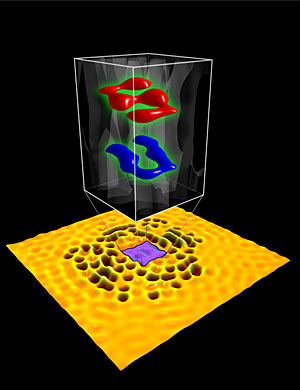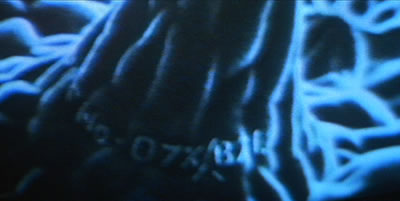Science Fiction
Dictionary
A B C D E F G H I J K L M N O P Q R S T U V W X Y Z
Stanford Writes Nano Letters 35 Bits Per Electron

Stanford University researchers have (once again) created the world's smallest writing. The letters are assembled from subatomic sized bits as small as 0.3 nanometers.
But in this experiment we've stored some 35 bits per electron to encode each letter. And we write the letters so small that the bits that comprise them are subatomic in size. So one bit per atom is no longer the limit for information density. There's a grand new horizon below that, in the subatomic regime. Indeed, there's even more room at the bottom than we ever imagined."
(Hari Manoharan, assistant professor of physics, Stanford)

(Stanford subatomic writing project)
The researchers encoded the letters "S" and "U" (as in Stanford University) within the interference patterns formed by quantum electron waves on the surface of a sliver of copper. The wave patterns even project a tiny hologram of the data, which can be viewed with a powerful microscope.Working in a vibration-proof basement lab in the Varian Physics Building, Manoharan and Moon began their writing project with a scanning tunneling microscope, a device that not only sees objects at a very small scale but also can be used to move around individual atoms. The Stanford team used it to drag single carbon monoxide molecules into a desired pattern on a copper chip the size of a fingernail.
On the two-dimensional surface of the copper, electrons zip around, behaving as both particles and waves, bouncing off the carbon monoxide molecules the way ripples in a shallow pond might interact with stones placed in the water. The ever-moving waves interact with the molecules and with each other to form standing "interference patterns" that vary with the placement of the molecules.
By altering the arrangement of the molecules, the researchers can create different waveforms, effectively encoding information for later retrieval. To encode and read out the data at unprecedented density, the scientists have devised a new technology, Electronic Quantum Holography.
A paper describing the research and the achievement has been published in Nature Nanotechnology by Hari Manoharan, Chris Moon, Laila Mattos, Brian Foster and Gabriel Zeltzer. The research was supported by the Department of Energy through SLAC National Accelerator Laboratory and the Stanford Institute for Materials and Energy Science (SIMES), the Office of Naval Research, the National Science Foundation and the Stanford-IBM Center for Probing the Nanoscale.
The first time I read about the idea that it might be possible to store information in such a small space was in Robert Heinlein's 1951 novel Between Planets; see the entry for the molecule matrix.
However, since this is physcially printed text, I was also thinking about the micro label from Blade Runner, the 1982 movie directed by Ridley Scott (from Philip K. Dick's 1968 novel Do Androids Dream of Electric Sheep?).
In the film, Deckard finds a small object that appears to be a fish scale. A street expert identifies it as artificial - pointing out the micro-sized serial number.

("I think it was manufactured... Finest quality. Superior workmanship..."
Micro label from Blade Runner)
By the time Blade Runner was planned and made, the idea of such small writing was already in the air. Nobel physics laureate Richard Feynman had offered a $1,000 prize for anyone who could find a way to print 25,000 times smaller than normal size. The prize was won in 1985 by Stanford graduate student Tom Newman who used electron beam lithography to engrave the first page of Dickens' A Tale of Two Cities in print that was readable only with an electron microscope.
Fans of tiny print might also like these articles - Ion-Etched Human Hair Shows Branding Possibilities and Atomic Pen Uses Atoms For Pixels. From Stanford News Service.
Scroll down for more stories in the same category. (Story submitted 2/17/2009)
Follow this kind of news @Technovelgy.| Email | RSS | Blog It | Stumble | del.icio.us | Digg | Reddit |
Would
you like to contribute a story tip?
It's easy:
Get the URL of the story, and the related sf author, and add
it here.
Comment/Join discussion ( 1 )
Related News Stories - (" Data Storage ")
Lonestar Offers Lunar Storage For Ultimate In Security
'Scarif, the off-site backup of all the secret knowledge of the Empire'
100X Improvement In DNA Information Storage
'A record that wouldn't get lost and couldn't be destroyed.' Barbara Hambly, 1982.
Twist Bioscience High Density Digital Data On DNA
'They tied the memory to the bloodline and that was their record!' - Barbara Humbly, 1982.
Store One Bit On One Atom
'...each individual molecule has a meaning.' - Robert Heinlein, 1951.
Technovelgy (that's tech-novel-gee!) is devoted to the creative science inventions and ideas of sf authors. Look for the Invention Category that interests you, the Glossary, the Invention Timeline, or see what's New.
Science Fiction
Timeline
1600-1899
1900-1939
1940's 1950's
1960's 1970's
1980's 1990's
2000's 2010's
Current News
Golf Ball Test Robot Wears Them Out
"The robot solemnly hit a ball against the wall, picked it up and teed it, hit it again, over and again...'
Boring Company Vegas Loop Like Asimov Said
'There was a wall ahead... It was riddled with holes that were the mouths of tunnels.'
Rigid Metallic Clothing From Science Fiction To You
'...support the interior human structure against Jupiterís pull.'
Is The Seattle Ultrasonics C-200 A Heinlein Vibroblade?
'It ain't a vibroblade. It's steel. Messy.'
Roborock Saros Z70 Is A Robot Vacuum With An Arm
'Anything larger than a BB shot it picked up and placed in a tray...'
A Beautiful Visualization Of Compact Food
'The German chemists have discovered how to supply the needed elements in compact, undiluted form...'
Bone-Building Drug Evenity Approved
'Compounds devised by the biochemists for the rapid building of bone...'
Secret Kill Switch Found In Yutong Buses
'The car faltered as the external command came to brake...'
Inmotion Electric Unicycle In Combat
'It is about the size and shape of a kitchen stool, gyro-stabilized...'
Grok Scores Best In Psychological Tests
'Try to find out how he ticks...'
PaXini Supersensitive Robot Fingers
'My fingers are not that sensitive...'
Congress Considers Automatic Emergency Braking, One Hundred Years Too Late
'The greatest problem of all was the elimination of the human element of braking together with its inevitable time lag.'
The Desert Ship Sailed In Imagination
'Across the ancient sea floor a dozen tall, blue-sailed Martian sand ships floated, like blue smoke.'
The Zapata Air Scooter Would Be Great In A Science Fiction Story
'Betty's slapdash style.'
Thermostabilized Wet Meat Product (NASA Prototype)
There are no orbiting Michelin stars. Yet.
Could Crystal Batteries Generate Power For Centuries?
'Power could be compressed thus into an inch-square cube of what looked like blue-white ice'
